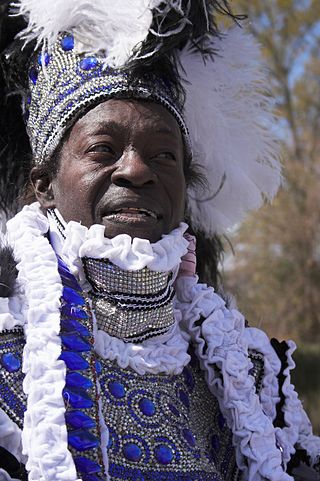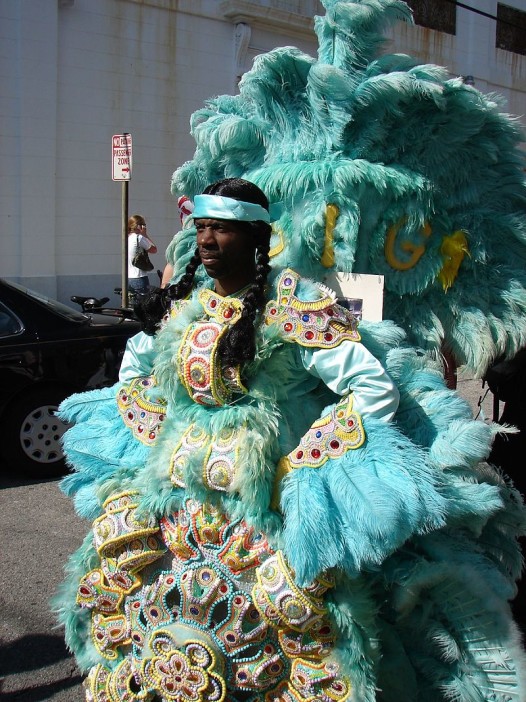MediaNOLA is a project of Tulane University and has received sponsorship from the Tulane School of Liberal Arts, the New Orleans Center for the Gulf South, Tulane Center for Public Service, Kentucky-Louisiana Learn and Serve, and the National Endowment for the Humanities.

Mardi Gras Indian: Bo Dollis
Mardi Gras Indians, sometimes referred to simply as “Injuns” by New Orleanians, have played an integral role in shaping the city’s parade and music culture. After an entire year of practicing the ritualized movements for each of the society’s positions and sewing elaborate suits, African American members of these New Orleans Tribes step out on Mardi Gras day, displaying their handiwork and demonstrating pride in their organization. Although Mardi Gras Indians have gained recognition throughout the country with documentaries and television shows like Treme, many people are confused as to how and why exactly the practice came to be. But like the history of New Orleans, the history of Mardi Gras Indians tells a story of multiple identities and various explanations of existence.
Let’s start with the Origins:
Several narratives about the birth of the Mardi Gras Indian tradition stem from the relationship between African Americans and Native Americans in New Orleans. Some Louisiana Native American tribes, including the Chickasaws, harbored African slaves who ran away from captivity. For this reason, some believe that Mardi Gras Indians started as a tribute to the race that provided them shelter. Furthermore, slaves and Native Americans lived close together within the city, as well: by 1890, the term “griffon,” meaning “black Indian” had been adopted to describe people of both African and Native American descent, adding to the already complex New Orleans racial code. Bacate Batiste, founder of the Creole Wild West (the first Mardi Gras Indian Tribe), as well as Allison “Tootie” Montana, Chief of the Yellow Pocahontas tribe and Batiste’s grand-nephew, claim to be part of this mixed African and Native American lineage. In turn, many people believe that the practice of masking as Native Americans is not only homage, but a demonstration of one’s cultural heritage.
How about the connection to Native Americans:
While it is true that many Mardi Gras Indians today have some Native American ancestry, the link between these two groups does not fully explain this cultural phenomenon. With very rare exceptions, Mardi Gras Indian suits resemble those of the Plains Indians, not the Southeastern Indians with whom some claim a shared heritage. In fact, several scholars have made the connection between Mardi Gras Indians and the Wild West shows that travelled to New Orleans in the 1880s. According to Ned Sublette, Batiste’s Creole Wild West took inspiration from these shows. However, as Sublette writes, “Becate Batiste’s Creole Wild West wasn’t the beginning of something from scratch… it was a way of giving form to something that was already going on.”
The appropriation of Native American identity by African American was, and still is, an expression of something much more than symbolic gratitude or a celebration of ancestryit is a powerful statement about group recognition and strength. Like Native Americans, African slaves endured myriad hardships and almost lost their identity at the hands of white European settlers. As George Lipsitz explains, “the Indian image calls attention to the initial genocide upon which American ‘civilization’ rests. It challenges the core dualism of American racism that defines people as either white or black.”
By dressing as Native Americans, African Americans demonstrate resistance against slavery and racial stereotypes; they exhibit pride, strength, and group solidarity, appropriating Native American ideas of Chief-based organization as their core. New Orleans, a city whose existence itself confronted the pervasive American black/white paradigm, was therefore the perfect environment for the Mardi Gras Indian tradition to flourish.

Big Chief Trouble Nation (Mardi Gras Indian)
Violence Between Tribes
Originally, Mardi Gras Indian tribes were more like gangs than benevolent societies. Carrying hatchets and spears, various tribes would meet up to settle their “beefs” through violence. Now, however, the dueling tradition of the past is only symbolic. Lipsitz writes that once “urban renewal destroyed the basis for neighborhood competitions,” these violent acts were transformed into “symbolic aesthetic competition.” This transition from warfare to friendly rivalry highlights the importance Mardi Gras Indian tribes had in establishing a sense of unity within New Orleans’s African American community and explains why they are still such a large facet of life in New Orleans today.
Dances and Songs
As the Indian tribes travel throughout New Orleans neighborhoods, they spin and pose in imitation of Native American war dances. This dancing is particularly critical to the mock battles the members engage in when two tribes encounter each other. The big chiefs spin around one another, flourishing their costumes, and engage in special chants and songs, with each demanding that the other “humba” or admit inferiority. The change from actual fighting to competitive showmanship is attributed to Big Chief “Tootie” Montana’s influence. As told by his widow, Joyce Montana, “Tootie was the one who said ‘We have to stop fighting with the guns. Now you fight with the suits.’ Then they were competing to see who was prettiest, and Tootie was always the prettiest.”
Mardi Gras Indians also utilize various chants and songs when masking that both continue the Indian image by mimicking Native American songs and war chants, and carry the functional purpose of conveying messages to one another. Many of the songs and chants contain a combination of various words either derived from Creole French terminology or loosely based on the numerous African dialects that the original New Orleans slaves brought with them. Of the Mardi Gras Indian songs, one of the best-known and most recognizable is known as either “Indian Red” or the “Indian Prayer” and is used to begin and end both practices and processions. This song also carries the significance of identifying the various members of the tribe and their positions.
Tribal Hierarchies:
The Mardi Gras Indian tribes feature a detailed social hierarchy that places various members in positions with specialized roles.
The highest position within the tribe is that of “Big Chief”, who decides the routes that the tribe travels and is the primary participant in mock battles between other tribes. Typically this role is earned by members and the Big Chief is often the most elaborately dressed of all of the Indians. The procession also often includes Second Chiefs and Trail Chief. Each Chief has a ceremonial Queen, who is often a family member of the chief but is not necessarily his wife.
The procession is led a Spyboy, who travels several blocks ahead of the Big Chief and alerts him to any incoming tribes or issues along the route using specially chosen hand signals or yells.
The tribe’s Flagboy, travels between the Big Chief and Spyboy and uses a ceremonial flag, usually adorned with large feathers and bearing the tribe’s emblem to relay signals between the two.
Tribes also often feature a Wild Man, who is denoted by his ceremonial weapon and whose responsibilities include keeping crowds from the Big Chief and clearing space for the Chiefs to do battle when tribes encounter each other.
There’s always more to learn when it comes to New Orleans, and this is just our bit about the Mardi Gras Indians. The best way to learn more, though, is to get out there to watch them do their thing.
This information was cross posted from MediaNOLA, a NolaVie content partner.






[…] that was utilized not only for day-to-day pleasure and relaxation but acted as a ritualized space for the observation of the Mardi Gras Indians and the Zulu parades. Native to the […]